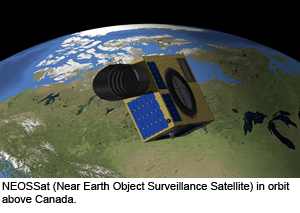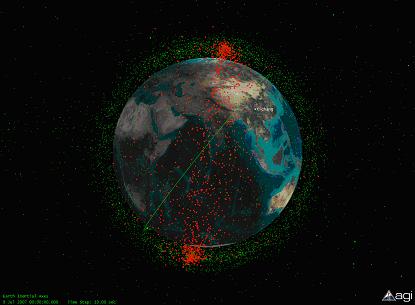The Canadian NEOS-Sat satellite being built these days will use cutting-edge technology to detect near-Earth objects including asteroids and satellites in orbit

These days Canada is building the space telescope NEOS-Sat (or in its full name - Near Earth Object Surveillance Satellite) whose purpose is to locate near-Earth asteroids and artificial satellites in orbit. This is the first satellite of its kind in the world and it will significantly improve the tracking of bodies that are on a collision course with the Earth or with other instruments in orbit. It is a micro-satellite weighing 65 kg with a 15 cm telescope, and will be placed at an altitude of 700 km above the Earth in 2010.
The search for near-Earth bodies is currently carried out by thousands of ground telescopes around the planet, each of them "pictures" the sky several times a day and feeds the information to supercomputers that detect changes in relation to other images from the same area, changes in the images indicate the movement of bodies in space. After detection, astronomers catalog them and try to calculate their expected trajectory.
The problem with the current method is that the rotation of the Earth does not allow scientists to look at a certain point in the sky throughout the day. The ideal solution is to place telescopes in space that will work 24 hours a day, but until now this has been avoided due to the high cost. Technological progress in the field of space in general and in the construction of microsatellites in particular has reduced the costs significantly and the cost of NEOS is only 12 million dollars when the funding comes from the Canadian Ministry of Defense and the Canadian Space Agency.
The information collected by the NEOS satellite will complete the picture for two other projects that monitor asteroids and debris in space, the NESS project which aims to search for asteroids in the vicinity of the Earth (Near Earth Space Surveillance) and the HEOSS project which operates at a higher altitude (High Earth Orbit Space Surveillance).

Dr. Brad Wells heads the scientific team of the Canadian Ministry of Defense in the HEOSS project, the information obtained from the new satellite will help not only in locating asteroids but also in controlling artificial satellites in high orbit. According to Dr. Wells, experiments have already been carried out with the new technology and it has been proven that it can detect not only asteroids but also artificial satellites. If we know the exact trajectory of each satellite, we can prevent collisions and manage freeways around the Earth.
According to Captain Tony Morris, accurate tracking of the movement around the Earth will give an advantage to the Canadian Armed Forces and will allow the country to safely and effectively manage strategic space assets - military and civilian.

7 תגובות
Galileo has a roller coaster
Once, two hundred years ago, they fought against the United States. Such a satellite would help them a lot.
May we (and them) have a quiet week
Sabdarmish Yehuda
You are missing the point
Canadian satellite!!!
Laugh or cry is up to you
"The satellite will be used for military purposes" - why with whom do they have a war????????????
All the questions asked here have an answer in the link to the original text and in the link to the website indicated from this text.
For all of them except a question about the Canadian army, for which you can find an answer, for example, here:
http://www.skyhawks.forces.gc.ca/lf/english/6_1.asp
to the cool responder
Quote from the article:-
"According to Captain Tony Morris, accurate tracking of the movement around the Earth will give an advantage to Canada's armed forces and allow the country to safely and effectively manage strategic space assets - military and civilian." End quote.
FYI:- Canada has an army.
good week
Sabdarmish Yehuda
What about Canada and the army?!
Yehuda I too thought about these exact questions while reading the article.
The article leaves several open questions:-
What is the state-of-the-art technology in question, is it the fact that the search is done outside the atmosphere? How will a 15 cm Keto telescope do the job? It is supposed to discover the asteroids when they are very far from the Earth, when they are close it is too late.
Does such a small telescope that stands outside the atmosphere really have an advantage over the large telescopes placed on Earth? How will they fix it in space, by placing it at one of the Lagrange points, or, at a low altitude using the methods in which the Hubble Space Telescope is stabilized?
I think that this is mainly a military satellite that will sometimes be used for research purposes in space. Simply, it sounds better to say that it is a cosmological research satellite.
Good Day
Sabdarmish Yehuda